The honey bee life cycle consists of four stages: egg, larva, pupa, and adult. Understanding this cycle is crucial for managing hive health and pollination efficiency.
1.1 Overview of the Honey Bee Life Cycle
The honey bee life cycle includes four distinct stages: egg, larva, pupa, and adult. Each stage serves a specific purpose in the development of the bee. Eggs hatch into larvae, which are fed royal jelly and honey to promote growth. The larval stage transitions into the pupal stage, where the bee undergoes metamorphosis within its cell. Finally, the adult bee emerges, ready to assume its role within the hive. This cycle ensures the continuous survival and productivity of the colony, with different castes (queen, worker, drone) fulfilling essential functions. Understanding this process is vital for beekeeping and pollination management.
1.2 Importance of Understanding the Life Cycle
Understanding the honey bee life cycle is crucial for effective beekeeping, pollination management, and environmental conservation. It helps beekeepers identify potential issues early, ensuring colony health and productivity. Knowledge of the life cycle aids in recognizing threats like diseases, pests, or nutritional deficiencies. Additionally, it informs strategies for maintaining ecological balance, as honey bees are key pollinators. This understanding also supports conservation efforts, addressing challenges like hive losses and habitat decline. By grasping the life cycle, bee enthusiasts can better appreciate the intricate social structure of honey bees and contribute to their survival, benefiting both agriculture and ecosystems globally.
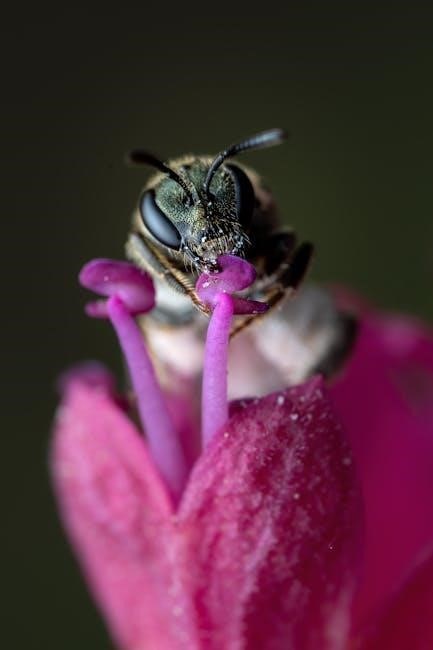
The Egg Stage
The egg stage begins with the queen laying eggs in honeycomb cells. Eggs hatch into larvae after 3–4 days. The queen regulates egg-laying based on hive needs.
2.1 How the Queen Bee Lays Eggs
The queen bee is the sole egg-layer in the colony, capable of laying up to 2,000 eggs daily during peak seasons. She deposits eggs in wax cells within the honeycomb, carefully selecting cell size and orientation. The queen determines the egg’s destiny by choosing whether to fertilize it, which dictates if it will become a worker or a drone. Fertilized eggs develop into female workers, while unfertilized ones become male drones. The queen’s egg-laying activity is influenced by hive needs, seasonality, and her genetic predisposition. This process is vital for colony growth and survival, ensuring a steady supply of new bees.
2.2 The Role of Worker Bees in Egg Care
Worker bees play a crucial role in egg care, ensuring the survival and development of future colony members. After the queen lays eggs, workers clean and prepare the cells, maintaining optimal conditions for incubation. They regulate hive temperature, ensuring eggs develop properly. Worker bees also feed royal jelly to larvae destined to become queens, while future workers receive a mixture of pollen and honey. This meticulous care ensures healthy development and determines the caste of each bee. Their dedication to egg care is vital for the colony’s growth and continuity, showcasing their importance in the hive’s social structure and survival.
2.3 Differences in Eggs for Workers, Queens, and Drones
Honey bee eggs differ in their development based on caste. Worker and queen eggs are fertilized, while drone eggs are unfertilized. Queens are larger and develop from eggs fed royal jelly throughout their larval stage. Worker eggs are smaller, fed royal jelly initially, then pollen and honey. Drone eggs are larger than worker eggs but smaller than queen eggs. The cell structure also varies: queen cells are larger and protrude from the comb, while worker and drone cells are within the comb. These differences ensure proper caste development and colony structure, crucial for hive function and survival.
The Larval Stage
The larval stage is a critical growth period where larvae are fed and develop rapidly, cared for by worker bees, before entering the pupal stage.
3.1 Feeding and Development of Larvae
Larvae are fed by worker bees, who provide royal jelly initially and later transition to honey and pollen. This diet ensures proper growth and development. The larvae molt several times as they grow, developing physically and preparing for their future roles. Worker bees continuously care for the larvae, ensuring they receive adequate nutrition. This stage lasts about one week, during which the larvae grow significantly. Proper feeding is crucial for determining their caste and future responsibilities within the hive. The larvae’s development during this stage sets the foundation for their adult roles.
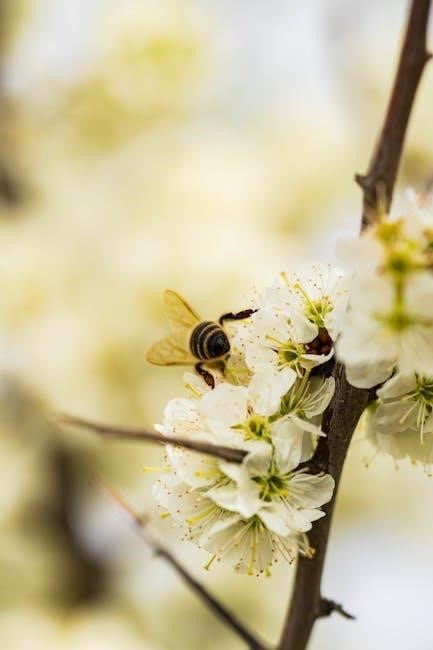
3.2 The Role of Royal Jelly in Larval Development
Royal jelly is a nutrient-rich secretion produced by worker bees, playing a crucial role in larval development. It is fed to all larvae initially, but only future queen larvae receive it throughout their development. Royal jelly is high in proteins, vitamins, and minerals, promoting rapid growth. Worker larvae are switched to honey and pollen after a few days, while queens continue with royal jelly, ensuring their larger size and reproductive capabilities. This dietary difference determines caste and future roles, highlighting royal jelly’s significance in honey bee social hierarchy and colony health.
3.3 Determining the Caste of the Larva
The caste of a honey bee larva is determined by factors such as diet, cell size, and pheromones. Larvae in larger cells, fed royal jelly and pollen, develop into queens. Those in smaller cells receive less royal jelly and more pollen, becoming worker bees. Drones arise from larvae in larger cells but without royal jelly. Pheromones from the queen also influence caste development. This system ensures the colony’s social structure, with each caste fulfilling specific roles. The precise control of nutrition and environment allows the hive to maintain balance and efficiency in its growth and survival.
The Pupal Stage
The pupal stage involves transformation within sealed cells, as larvae develop into adult bees. Worker bees cap cells, and pupae undergo metamorphosis, emerging as adults.
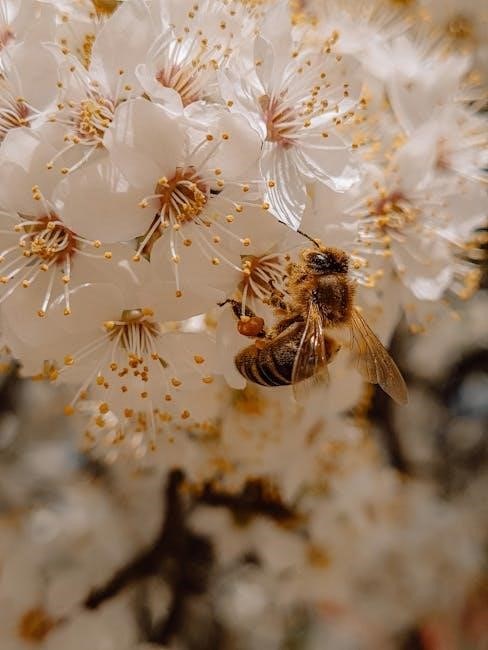
4.1 Sealing the Cell and Pupal Transformation
Worker bees seal the cell with wax once the larva spins its cocoon, creating a protective environment for pupal development. Inside, the pupa undergoes metamorphosis, transforming larval tissues into adult structures like wings and eyes. This stage is critical for proper development, as any disturbance can lead to deformities. The sealed cell ensures the pupa remains undisturbed, allowing it to emerge as a fully formed adult bee. The duration varies by caste, with workers, queens, and drones having distinct timelines. This transformation is vital for colony continuity, as it ensures the next generation of bees is healthy and functional.
4.2 Duration of the Pupal Stage
The pupal stage duration varies depending on the bee’s caste. Worker bees typically spend 10-14 days in this stage, while queens develop faster, taking about 7-8 days. Drones, being larger, require 14-15 days. These timelines ensure proper development of adult features. Environmental factors like temperature can influence the duration, but generally, the colony’s health and productivity rely on these consistent timelines. Understanding these durations helps beekeepers monitor hive health and anticipate new bee emergence, which is essential for maintaining a thriving colony and ensuring pollination activities remain uninterrupted.
4.3 Emergence of the Adult Bee
The adult bee emerges from the pupal stage by chewing through the wax capping of its cell. This process is crucial for the bee to begin its adult life. Newly emerged bees are initially weak and require care from worker bees. They start by cleaning their cells and gradually take on hive responsibilities. The emergence marks the final stage of development, after which the bee joins the colony as a functional member. This transition is vital for colony growth and productivity, ensuring the continuation of hive operations and pollination activities. The timing and success of emergence are critical for hive health and sustainability.
The Adult Stage
The adult stage is the final phase of the honey bee life cycle, where bees emerge fully developed and take on specific roles within the hive.
5.1 Roles of Worker Bees
Worker bees, all female, perform essential tasks for the hive. They forage for nectar, pollen, and water, produce wax, and construct the hive. They store food by evaporating water from nectar to create honey and beeswax. Workers also clean cells, care for larvae, and guard the hive entrance. They tend to the queen and drones, ensuring their needs are met. As they age, workers take on more dangerous tasks like foraging. Their lifespan varies by season, with summer workers living 4-6 weeks and winter workers surviving up to 4 months. Their dedication ensures the colony’s survival and prosperity.
5.2 The Life and Role of the Queen Bee
The queen bee is the heart of the hive, with a lifespan of up to five years. Her primary role is to lay eggs, producing up to 2,000 daily. The queen’s pheromones regulate hive unity and control drone production. She develops from larvae fed royal jelly, ensuring genetic superiority. Colonies thrive under a strong queen, as her egg-laying ensures continuous growth. If she weakens, workers replace her through a process called supersedure. The queen’s health directly impacts the colony’s success, making her indispensable to the hive’s survival and productivity.
5.3 The Function and Life Cycle of Drones
Drones are male honey bees, born from unfertilized eggs, with the sole purpose of mating with the queen. They develop from larvae in larger cells and take about 24 days to mature. Drones are larger than workers and lack stingers. Their lifespan varies; summer drones live 4-6 weeks, while winter drones survive up to 4 months. Drones do not gather food or build the hive, focusing solely on reproduction. They play a critical role in colony genetics but are expendable once their mating role ends.
5.4Behavior and Communication in Adult Bees
5.4 Behavior and Communication in Adult Bees
Adult honey bees exhibit complex behaviors and communication systems. Worker bees perform tasks based on age, from cleaning cells to foraging. The waggle dance communicates food sources’ direction and distance. Pheromones, like those from the queen, regulate hive activities. Drones focus on mating, while workers handle hive maintenance, defense, and food collection. Bees also use touch and vibrations to convey information. This sophisticated communication ensures colony efficiency and survival, highlighting their social structure’s adaptability and coordination, which is essential for their success as a colony.
5.5 Social Structure Within the Hive
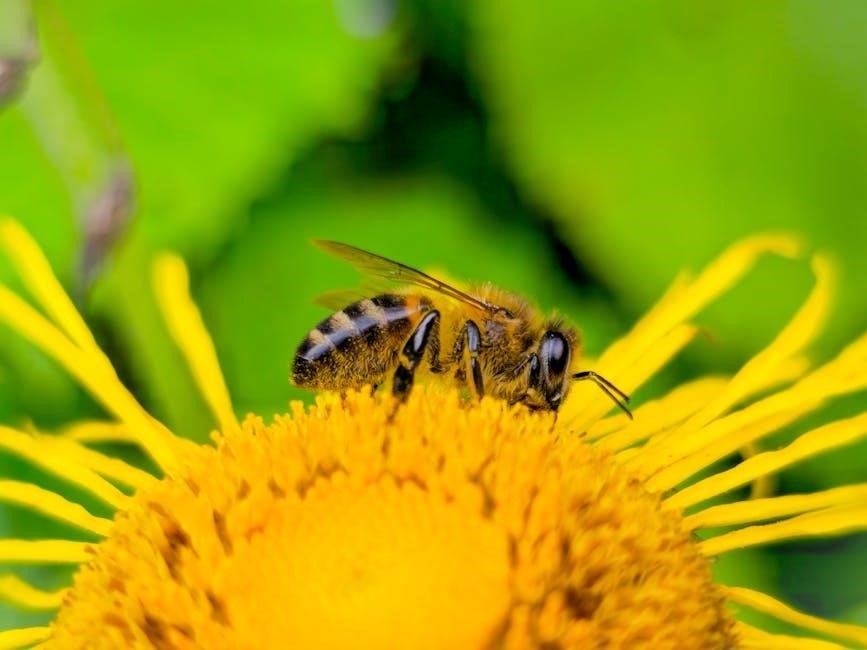
The social structure of a honey bee hive is a strict hierarchy essential for colony survival. The queen bee is at the top, laying eggs and ensuring the colony’s growth. Worker bees, all female, handle tasks like foraging, caring for young, and defending the hive. Drones, male bees, focus solely on mating. This division of labor creates a highly efficient society. The hive’s social order is maintained through pheromones, ensuring each bee understands its role. This structured system allows the colony to thrive, with each caste contributing uniquely to the hive’s overall health and productivity, emphasizing the importance of cooperation in their survival.
5.6 Lifespan and Seasons
The lifespan of honey bees varies significantly among castes and is influenced by seasonal changes. Worker bees typically live for 4-6 weeks during summer, while those emerging in fall may survive winter. Drones usually die after mating, as their role is complete. The queen, however, can live for up to 5 years. Seasonal fluctuations affect colony activities, with summer being a period of high productivity and winter requiring conservation of resources. This cycle ensures the colony adapts to environmental changes, maintaining its strength through the year. The bees’ lifespan and seasonal behaviors are crucial for the colony’s survival and continuity.
The Social Hierarchy of the Hive
The hive operates under a strict caste system, with the queen at the top, followed by worker bees and drones, each fulfilling distinct roles for colony survival.
6.1 The Queen Bee’s Dominance
The queen bee is the heart of the hive, laying up to 2,000 eggs daily, ensuring colony growth and genetic continuity. Her pheromones regulate worker behavior and maintain social cohesion. The queen’s dominance is absolute, with workers attending exclusively to her needs. This hierarchy ensures efficient hive operations, as the queen focuses solely on reproduction while workers handle all other tasks. Her presence is vital for the colony’s survival, as her pheromones prevent worker ovaries from developing, preserving the hive’s strict social order and ensuring the queen’s uninterrupted reign as the reproductive core of the colony.
6.2 Worker Bees and Their Responsibilities
Worker bees, all female, are the backbone of the hive, performing diverse tasks essential for colony survival. Young workers clean cells, feed larvae, and produce wax, while older workers forage for nectar, pollen, and water. They also defend the hive and maintain its structure. Workers communicate through complex dances, ensuring efficient resource gathering. Their lifespan is about six weeks during summer, a testament to their relentless work ethic. By dividing labor based on age and experience, worker bees ensure the hive’s smooth operation, supporting the queen and overall colony growth through their collective efforts and dedication.
6.3 The Role of Drones in the Hive
Drones are male honey bees, primarily responsible for mating with the queen. They are larger and stouter than worker bees, with no stingers or ability to gather food. Drones rely on worker bees for care and nutrition, focusing solely on reproduction. Typically produced in spring and summer, drones mate with the queen during flights, ensuring genetic diversity. Queens regulate drone numbers, and excess drones are often expelled in fall. Despite their limited roles, drones are vital for the colony’s survival, emphasizing the queen’s reproductive success and the hive’s genetic health through their unique contribution.
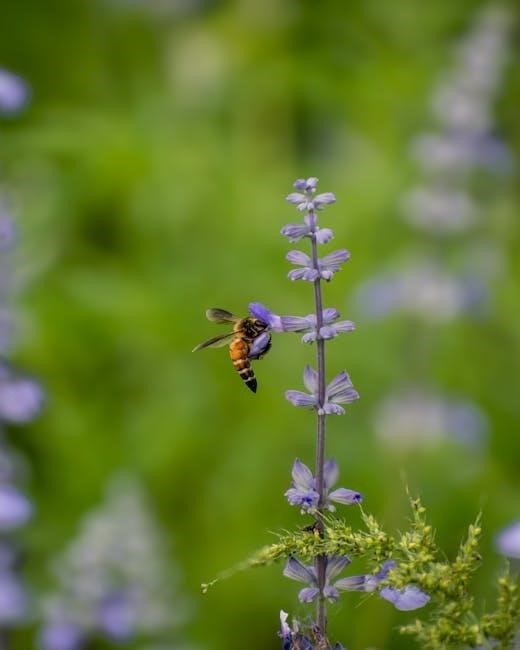
Development and Growth of the Colony
The colony grows as the queen lays eggs and workers expand the hive. Seasonal changes, food availability, and the queen’s health determine the colony’s size and strength.
7.1 Seasonal Changes in Colony Size
The size of a honey bee colony fluctuates with the seasons. In spring, colonies grow rapidly as the queen increases egg production, and workers gather abundant food. Summer brings the hive to its peak population, with thousands of bees. In fall, colonies reduce in size as the queen slows egg-laying, and workers prepare for winter. During winter, the colony clusters tightly to conserve heat, surviving on stored honey. These seasonal changes are crucial for the colony’s survival, ensuring resources are managed efficiently throughout the year.
7.2 The Importance of the Queen in Colony Growth
The queen bee is central to colony growth, as her egg-laying determines population size. She can produce up to 2,000 eggs daily, ensuring a steady supply of new bees. The queen’s pheromones regulate worker behavior, maintaining hive unity. Her presence prevents workers from raising new queens, preserving colony stability. Without a healthy queen, the colony struggles to grow, leading to eventual decline. Thus, the queen’s role is vital for sustaining and expanding the hive, making her the cornerstone of colony success and reproduction.
7.3 How Worker Bees Maintain the Colony
Worker bees are crucial for colony maintenance, performing tasks like hive construction, foraging, and caring for young. They build honeycombs using wax produced from their bodies and gather nectar and pollen for food. Workers also feed larvae, clean cells, and dispose of debris. Additionally, they regulate hive temperature and guard the colony from predators. Their collective efforts ensure the colony’s survival and growth, demonstrating their vital role in sustaining the hive’s health and productivity throughout the honey bee life cycle.
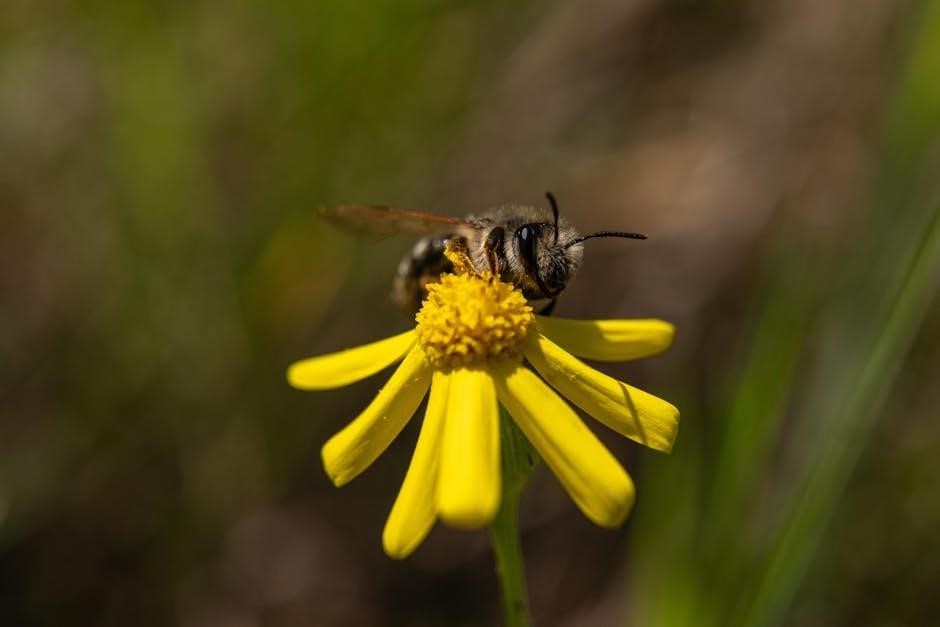
Beekeeping and the Life Cycle
Beekeeping plays a vital role in supporting the honey bee life cycle by ensuring hive health and productivity. Beekeepers monitor colony health, control pests, and provide resources, ensuring bees thrive throughout their life stages.
8.1 How Beekeeping Affects the Life Cycle
Beekeeping significantly impacts the honey bee life cycle through targeted interventions. Beekeepers monitor hive conditions, control pests, and manage resources, influencing egg laying, larval development, and adult emergence. By ensuring optimal hive health, beekeepers prevent developmental disruptions and support colony growth. Regular inspections and queen management strategies also help maintain the balance between worker, drone, and queen production. These practices ensure the colony remains robust, enabling bees to progress smoothly through their life stages without external threats. Beekeeping thus plays a crucial role in sustaining and enhancing the natural life cycle of honey bees.
8.2 The Role of Beekeepers in Maintaining Healthy Colonies
Beekeepers play a vital role in ensuring the health and productivity of honey bee colonies. They conduct regular inspections to monitor for diseases, pests, and nutritional issues. By maintaining clean hives, controlling parasites, and providing adequate food sources, beekeepers create an optimal environment for bees to thrive. They also manage hive populations, split colonies to prevent overcrowding, and replace aging or diseased queens. These practices help maintain genetic diversity and prevent the spread of infections. Beekeepers’ interventions ensure the colony remains strong, enabling bees to focus on their life cycle stages without external stressors, which is crucial for overall hive health and productivity.
8.3 Harvesting Honey and Its Impact on Bees
Honey harvesting is a critical beekeeping practice that, when done responsibly, ensures the sustainability of both the colony and honey production. Beekeepers extract honey during peak nectar flows, leaving enough for the bees to survive winter. Modern methods, like using centrifugal extractors, minimize damage to honeycombs, allowing bees to reuse them. However, over-harvesting can stress colonies, reducing their honey reserves and weakening their ability to survive. Balancing honey production with colony health is essential to maintain thriving bee populations and ensure the life cycle continues uninterrupted. Responsible harvesting practices are vital for the long-term sustainability of honey bees and their ecosystems.
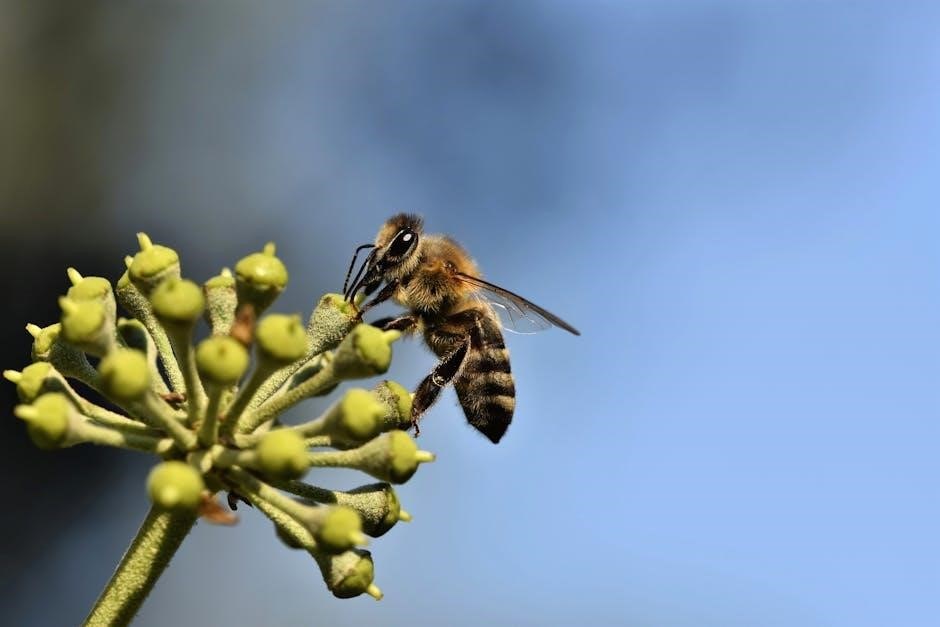
Threats to Honey Bee Colonies
Habitat loss, invasive species, and Colony Collapse Disorder threaten honey bee colonies, impacting their life cycle and survival rates significantly.
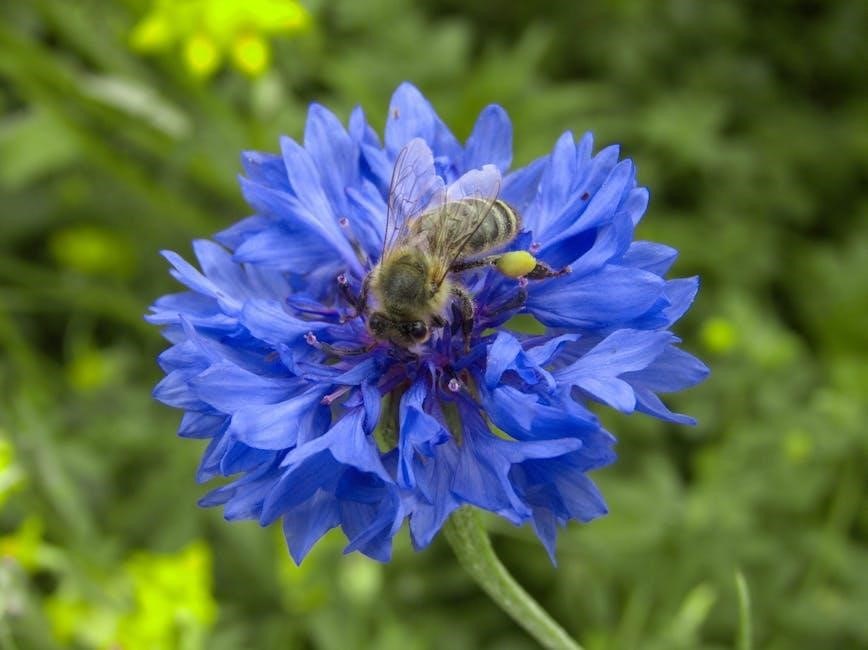
9.1 Pesticides and Their Effects
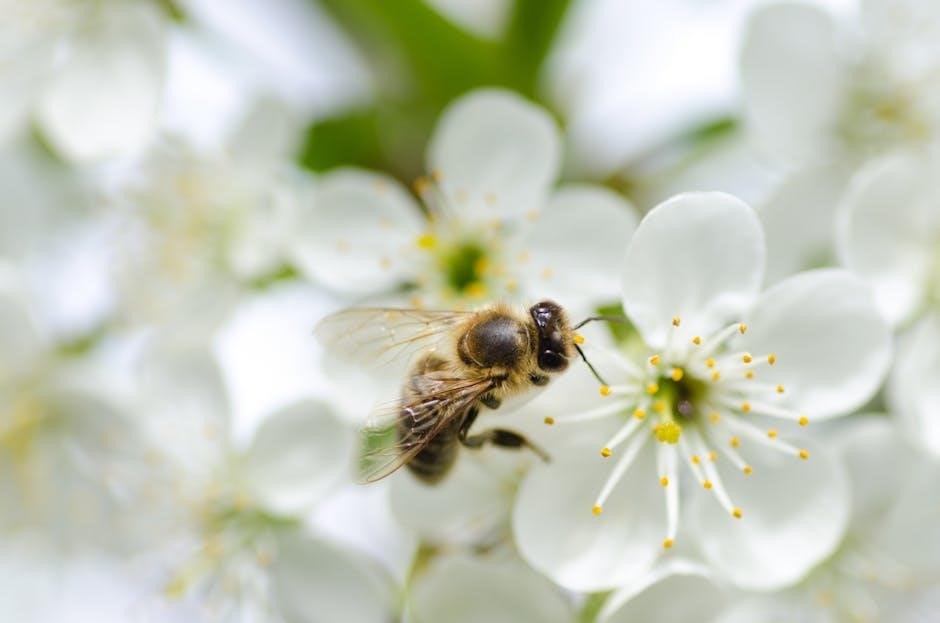
Pesticides pose a significant threat to honey bee colonies by disrupting their nervous systems and impairing their ability to navigate and communicate. Exposure to these chemicals, often through contaminated nectar and pollen, can lead to colony-wide issues such as reduced foraging efficiency and impaired hive communication. This disruption can weaken the colony’s social structure, affecting the queen’s egg-laying capacity and worker bees’ ability to care for larvae. Pesticides also exacerbate stress on the hive, making it harder for colonies to recover from other threats like diseases and parasites. Their widespread use in agriculture highlights the need for safer alternatives to protect pollinators and ensure colony survival.
9.2 Climate Change and Resource Availability
Climate change disrupts the delicate timing of honey bee life cycles by altering flowering patterns and resource availability. Warmer temperatures cause plants to bloom earlier, creating mismatches between when bees need nectar and pollen and when these resources are available. This disruption can lead to malnutrition, especially for larvae, which rely on worker bees to gather food. Additionally, extreme weather events like heatwaves and droughts further stress colonies, reducing hive productivity and survival rates. These changes threaten the stability of honey bee populations and their ability to adapt to shifting environmental conditions.
9.3 Diseases and Parasites Affecting Bees
Diseases and parasites pose significant threats to honey bee colonies, impacting their life cycle and survival. Varroa mite infestations are particularly devastating, weakening bees and spreading viruses. Nosema, a fungal infection, disrupts digestion and reduces lifespans, especially in worker bees. American foulbrood, a bacterial disease, can destroy entire colonies by infecting larvae. These pathogens often target specific stages of the life cycle, such as eggs or larvae, causing developmental issues and colony-wide health declines. Managing these threats is critical to maintaining healthy colonies and ensuring the survival of honey bees.